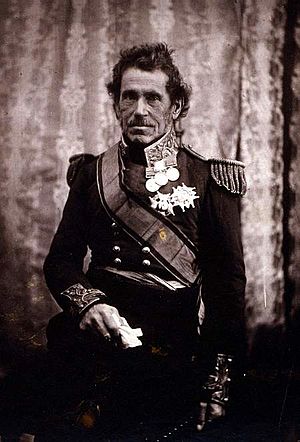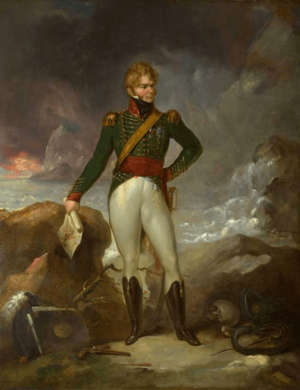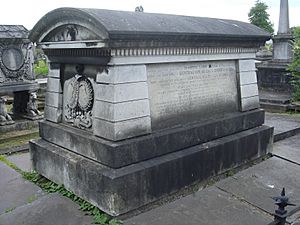George de Lacy Evans facts for kids
Quick facts for kids
Sir George de Lacy Evans
|
|
|---|---|

Evans photographed in 1855
|
|
| Born | 7 October 1787 Moig, County Limerick, Ireland |
| Died | 9 January 1870 |
| Allegiance | United Kingdom |
| Service/ |
British Army |
| Rank | General |
| Commands held | British Legion 2nd Division |
| Battles/wars | War of 1812:
Crimean War |
| Awards | Knight Grand Cross of the Order of the Bath Grand Cross of the Legion of Honour (France) |
| Other work | Member of Parliament |
General Sir George de Lacy Evans GCB (born October 7, 1787 – died January 9, 1870) was a brave British Army general. He fought in four major wars during the 1800s. After his military career, he became a Member of Parliament, which means he helped make laws for the country.
Contents
A Life of Military Service
Early Years and First Battles
George de Lacy Evans was born in 1787 in Moig, a place in Ireland. He went to Woolwich Academy, a famous military school. Like his older brother, he joined the military. He first served with the East India Company in 1800. Later, in 1806, he joined the regular British Army in India.
In 1807, he became an ensign in the 22nd Regiment of Foot. He then moved to the 3rd Light Dragoons to fight in the Peninsular War in Europe.
The War of 1812 in America
In 1814, Evans was sent to the United States during the War of 1812. He worked closely with Major General Robert Ross. Evans was a quartermaster general, helping with supplies and planning.
He was part of important events like the Battle of Bladensburg on August 24, 1814. He also saw the Burning of Washington, where British troops set fire to parts of the capital. Evans was also at the Battle of North Point on September 12, 1814, where General Ross was killed.
Evans was also involved in the New Orleans campaign at the end of the War of 1812. He was the only British Army officer present during a small boat battle on Lake Borgne. He was also wounded during the main battle of New Orleans.
Fighting Napoleon in Europe
After his time in America, Evans returned to Europe. He fought when Emperor Napoleon I returned to power. Evans was present at the battle of Quatre Bras on June 16, 1815. Just two days later, he fought in the famous battle of Waterloo on June 18, 1815. This battle marked the final defeat of Napoleon.
Later Military Commands
Even though he had never been to Central Asia, Evans worried about Russia's plans. He thought Russia might try to attack India through Central Asia. He wrote two books about this threat in 1828 and 1829. His books helped convince British leaders to gather information about possible invasion routes into India. This was part of a period known as the Great Game, where Britain and Russia competed for influence in Central Asia.
Evans later commanded the British Legion. This was a group of British volunteers who helped Isabella II of Spain during the First Carlist War (1833-1840) in Spain.
The Crimean War
During the Crimean War (1853-1856), Evans commanded the 2nd Division of the British Army. He fought bravely at the Battle of the Alma in 1854. Around the time of the Battle of Inkerman, he became sick and had to go home to recover.
In 1853, he was made the colonel for life of the 21st Regiment of Foot (Royal North British Fusiliers). He was promoted to full general on March 10, 1861.
A Career in Politics
Besides his military service, Sir George de Lacy Evans also had a long career in politics. He served as a Member of Parliament (MP) for different areas. He represented Rye in 1830, and again from 1831 to 1832. He then represented Westminster from 1833 to 1841, and again from 1846 to 1865.
He was also given the Grand Cross of the French Legion of Honour, a very high award from France.
Advocating for Army Reform
From the mid-1850s, Evans became a strong supporter of changes in the British army. He was very critical of a system where army officers had to pay money to get promoted. This was called the "purchase system." He believed this system was unfair and needed to be stopped. Although he passed away in 1870, just before the system was finally ended in 1871, his strong efforts helped lead to its removal.
Sir George de Lacy Evans died on January 9, 1870. He is buried in Kensal Green Cemetery in London. His medals and awards are on display at the Queens Own Royal Hussars Museum in Warwick.
See also
 In Spanish: George Lacy Evans para niños
In Spanish: George Lacy Evans para niños



